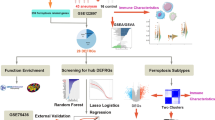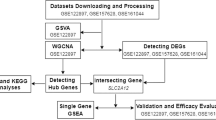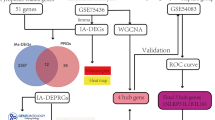Abstract
Objective and design
The prevalence of intracranial aneurysms (IAs) has increased globally. We performed bioinformatics analysis to identify key biomarkers associated with IA formation.
Methods and results
We conducted a comprehensive analysis combined with multi-omics data and methods to identify immune-related genes (IRGs) and immunocytes involved in IAs. Functional enrichment analyses showed enhanced immune responses and suppressed organizations of extracellular matrix (ECM) during aneurysm progression. xCell analyses showed that the abundance of B cells, macrophages, mast cells, and monocytes significantly increased from levels in control to unruptured aneurysms and to ruptured aneurysms. Of 21 IRGs identified by overlapping, a three-gene (CXCR4, S100B, and OSM) model was constructed through LASSO logistic regression. The diagnostic ability of the three biomarkers in discriminating aneurysms from the control samples demonstrated a favorable diagnostic value. Among the three genes, OSM and CXCR4 were up-regulated and hypomethylated in IAs, while S100B was down-regulated and hypermethylated. The expression of the three IRGs was further validated by qRT-PCR and immunohistochemistry and mouse IA model using scRNA-seq analysis.
Conclusion
The present study demonstrated heightened immune response and suppressed ECM organization in aneurysm formation and rupture. The three-gene immune-related signature (CCR4, S100B, and OSM) model may facilitate IA diagnosis and prevention.












Similar content being viewed by others
Availability of data and material
GEO belongs to public databases. The patients involved in the database have obtained ethical approval. Users can download relevant data for free for research and publish relevant articles. The original contributions presented in the study are included in the article/Supplementary Material. Further inquiries can be directed to the corresponding authors.
References
Vlak MH, Algra A, Brandenburg R, Rinkel GJ. Prevalence of unruptured intracranial aneurysms, with emphasis on sex, age, comorbidity, country, and time period: a systematic review and meta-analysis. Lancet Neurol. 2011;10:626–36. https://doi.org/10.1016/s1474-4422(11)70109-0.
Gabriel RA, Kim H, Sidney S, et al. Ten-year detection rate of brain arteriovenous malformations in a large, multiethnic, defined population. Stroke. 2010;41:21–6. https://doi.org/10.1161/strokeaha.109.566018.
Bakker MK, van der Spek RAA, van Rheenen W, et al. Genome-wide association study of intracranial aneurysms identifies 17 risk loci and genetic overlap with clinical risk factors. Nat Genet. 2020;52:1303–13. https://doi.org/10.1038/s41588-020-00725-7.
Ogilvy CS, Gomez-Paz S, Kicielinski KP, et al. Cigarette smoking and risk of intracranial aneurysms in middle-aged women. J Neurol Neurosurg Psychiatry. 2020;91:985–90. https://doi.org/10.1136/jnnp-2020-323753.
Macdonald RL, Schweizer TA. Spontaneous subarachnoid haemorrhage. Lancet (London, England). 2017;389:655–66. https://doi.org/10.1016/s0140-6736(16)30668-7.
Nieuwkamp DJ, Setz LE, Algra A, et al. Changes in case fatality of aneurysmal subarachnoid haemorrhage over time, according to age, sex, and region: a meta-analysis. Lancet Neurol. 2009;8:635–42. https://doi.org/10.1016/s1474-4422(09)70126-7.
Thompson BG, Brown RD Jr, Amin-Hanjani S, et al. Guidelines for the management of patients with unruptured intracranial aneurysms: a guideline for healthcare professionals from the American heart association/American stroke association. Stroke. 2015;46:2368–400. https://doi.org/10.1161/str.0000000000000070.
Frösen J, Cebral J, Robertson AM, Aoki T. Flow-induced, inflammation-mediated arterial wall remodeling in the formation and progression of intracranial aneurysms. Neurosurg Focus. 2019;47:E21. https://doi.org/10.3171/2019.5.Focus19234.
Can A, Du R. Association of hemodynamic factors with intracranial aneurysm formation and rupture: systematic review and meta-analysis. Neurosurgery. 2016;78:510–20. https://doi.org/10.1227/neu.0000000000001083.
Huang Z, Zeng M, Tao WG, et al. A hemodynamic mechanism correlating with the initiation of MCA bifurcation aneurysms. AJNR Am J Neuroradiol. 2020;41:1217–24. https://doi.org/10.3174/ajnr.A6615.
Turjman AS, Turjman F, Edelman ER. Role of fluid dynamics and inflammation in intracranial aneurysm formation. Circulation. 2014;129:373–82. https://doi.org/10.1161/circulationaha.113.001444.
Furukawa H, Wada K, Tada Y, et al. Mast cell promotes the development of intracranial aneurysm rupture. Stroke. 2020;51:3332–9. https://doi.org/10.1161/strokeaha.120.030834.
Kanematsu Y, Kanematsu M, Kurihara C, et al. Critical roles of macrophages in the formation of intracranial aneurysm. Stroke. 2011;42:173–8. https://doi.org/10.1161/strokeaha.110.590976.
Tulamo R, Frösen J, Junnikkala S, et al. Complement system becomes activated by the classical pathway in intracranial aneurysm walls. Lab Invest J Tech Methods Pathol. 2010;90:168–79. https://doi.org/10.1038/labinvest.2009.133.
Sawyer DM, Pace LA, Pascale CL, et al. Lymphocytes influence intracranial aneurysm formation and rupture: role of extracellular matrix remodeling and phenotypic modulation of vascular smooth muscle cells. J Neuroinflammation. 2016;13:185. https://doi.org/10.1186/s12974-016-0654-z.
Pera J, Korostynski M, Krzyszkowski T, et al. Gene expression profiles in human ruptured and unruptured intracranial aneurysms: what is the role of inflammation? Stroke. 2010;41:224–31. https://doi.org/10.1161/strokeaha.109.562009.
Kleinloog R, Verweij BH, van der Vlies P, et al. RNA sequencing analysis of intracranial aneurysm walls reveals involvement of lysosomes and immunoglobulins in rupture. Stroke. 2016;47:1286–93. https://doi.org/10.1161/strokeaha.116.012541.
Liu Y, Song Y, Liu P, et al. Comparative bioinformatics analysis between proteomes of rabbit aneurysm model and human intracranial aneurysm with label-free quantitative proteomics. CNS Neurosci Ther. 2021;27:101–12. https://doi.org/10.1111/cns.13570.
Shan D, Guo X, Yang G, et al. Integrated transcriptional profiling analysis and immune-related risk model construction for intracranial aneurysm rupture. Front Neurosci. 2021;15:613329. https://doi.org/10.3389/fnins.2021.613329.
Zhong A, Ding N, Zhou Y, et al. Identification of hub genes associated with the pathogenesis of intracranial aneurysm via integrated bioinformatics analysis. Int J Gen Med. 2021;14:4039–50. https://doi.org/10.2147/ijgm.S320396.
Aoki T, Koseki H, Miyata H, et al. RNA sequencing analysis revealed the induction of CCL3 expression in human intracranial aneurysms. Sci Rep. 2019;9:10387. https://doi.org/10.1038/s41598-019-46886-2.
Nakaoka H, Tajima A, Yoneyama T, et al. Gene expression profiling reveals distinct molecular signatures associated with the rupture of intracranial aneurysm. Stroke. 2014;45:2239–45. https://doi.org/10.1161/strokeaha.114.005851.
Ritchie ME, Phipson B, Wu D, et al. limma powers differential expression analyses for RNA-sequencing and microarray studies. Nucleic Acids Res. 2015;43: e47. https://doi.org/10.1093/nar/gkv007.
Yu G, Wang LG, Han Y, He QY. clusterProfiler: an R package for comparing biological themes among gene clusters. OMICS. 2012;16:284–7. https://doi.org/10.1089/omi.2011.0118.
Subramanian A, Tamayo P, Mootha VK, et al. Gene set enrichment analysis: a knowledge-based approach for interpreting genome-wide expression profiles. Proc Natl Acad Sci USA. 2005;102:15545–50. https://doi.org/10.1073/pnas.0506580102.
Aran D, Hu Z, Butte AJ. xCell: digitally portraying the tissue cellular heterogeneity landscape. Genome Biol. 2017;18:220. https://doi.org/10.1186/s13059-017-1349-1.
Bindea G, Mlecnik B, Tosolini M, et al. Spatiotemporal dynamics of intratumoral immune cells reveal the immune landscape in human cancer. Immunity. 2013;39:782–95. https://doi.org/10.1016/j.immuni.2013.10.003.
Langfelder P, Horvath S. WGCNA: an R package for weighted correlation network analysis. BMC Bioinformatics. 2008;9:559. https://doi.org/10.1186/1471-2105-9-559.
Ernst J, Bar-Joseph Z. STEM: a tool for the analysis of short time series gene expression data. BMC Bioinformatics. 2006;7:191. https://doi.org/10.1186/1471-2105-7-191.
Tian Y, Morris TJ, Webster AP, et al. ChAMP: updated methylation analysis pipeline for Illumina BeadChips. Bioinform (Oxford, England). 2017;33:3982–4. https://doi.org/10.1093/bioinformatics/btx513.
Li S, Tao W, Huang Z, et al. The transcriptional landscapes and key genes in brain arteriovenous malformation progression in a venous hypertension rat model revealed by RNA sequencing. J Inflamm Res. 2022;15:1381–97. https://doi.org/10.2147/jir.S347754.
Butler A, Hoffman P, Smibert P, Papalexi E, Satija R. Integrating single-cell transcriptomic data across different conditions, technologies, and species. Nat Biotechnol. 2018;36:411–20. https://doi.org/10.1038/nbt.4096.
Martinez AN, Tortelote GG, Pascale CL, et al. Single-cell transcriptome analysis of the circle of Willis in a mouse cerebral aneurysm model. Stroke. 2022;53:2647–57. https://doi.org/10.1161/strokeaha.122.038776.
Ruigrok YM, Rinkel GJ, van’t Slot R, et al. Evidence in favor of the contribution of genes involved in the maintenance of the extracellular matrix of the arterial wall to the development of intracranial aneurysms. Hum Mol Genet. 2006;15:3361–8. https://doi.org/10.1093/hmg/ddl412.
Zhang X, Ares WJ, Taussky P, Ducruet AF, Grandhi R. Role of matrix metalloproteinases in the pathogenesis of intracranial Aneurysms. Neurosurg Focus. 2019;47:E4. https://doi.org/10.3171/2019.4.Focus19214.
Pope FM, Nicholls AC, Narcisi P, et al. Some patients with cerebral aneurysms are deficient in type III collagen. Lancet (London, England). 1981;1:973–5. https://doi.org/10.1016/s0140-6736(81)91735-9.
Marchese E, Vignati A, Albanese A, et al. Comparative evaluation of genome-wide gene expression profiles in ruptured and unruptured human intracranial aneurysms. J Biol Regul Homeost Agents. 2010;24:185–95.
Shimada K, Furukawa H, Wada K, et al. Protective role of peroxisome proliferator-activated receptor-γ in the development of intracranial aneurysm rupture. Stroke. 2015;46:1664–72. https://doi.org/10.1161/strokeaha.114.007722.
Mitsui K, Ikedo T, Kamio Y, et al. TLR4 (toll-like receptor 4) mediates the development of intracranial aneurysm rupture. Hypertension (Dallas Tex: 1979). 2020;75:468–76. https://doi.org/10.1161/hypertensionaha.118.12595.
Mauri C, Bosma A. Immune regulatory function of B cells. Annu Rev Immunol. 2012;30:221–41. https://doi.org/10.1146/annurev-immunol-020711-074934.
Chyatte D, Bruno G, Desai S, Todor DR. Inflammation and intracranial aneurysms. Neurosurgery. 1999;45:1137–46. https://doi.org/10.1097/00006123-199911000-00024. (discussion 46-7).
Yamamoto R, Aoki T, Koseki H, et al. A sphingosine-1-phosphate receptor type 1 agonist, ASP4058, suppresses intracranial aneurysm through promoting endothelial integrity and blocking macrophage transmigration. Br J Pharmacol. 2017;174:2085–101. https://doi.org/10.1111/bph.13820.
Ikedo T, Minami M, Kataoka H, et al. Dipeptidyl peptidase-4 inhibitor anagliptin prevents intracranial aneurysm growth by suppressing macrophage infiltration and activation. J Am Heart Assoc. 2017. https://doi.org/10.1161/jaha.116.004777.
Chen S, Yang D, Liu B, et al. Identification and validation of key genes mediating intracranial aneurysm rupture by weighted correlation network analysis. Ann Trans Med. 2020;8:1407. https://doi.org/10.21037/atm-20-4083.
Hoh BL, Hosaka K, Downes DP, et al. Stromal cell-derived factor-1 promoted angiogenesis and inflammatory cell infiltration in aneurysm walls. J Neurosurg. 2014;120:73–86. https://doi.org/10.3171/2013.9.Jns122074.
Li ZF, Fang XG, Zhao R, et al. Stromal cell-derived factor 1α facilitates aneurysm remodeling in elastase-induced rabbit saccular aneurysm. Cytokine. 2018;102:123–30. https://doi.org/10.1016/j.cyto.2017.07.020.
Chen YH, Cheng ZY, Shao LH, Shentu HS, Fu B. Macrophage migration inhibitory factor as a serum prognostic marker in patients with aneurysmal subarachnoid hemorrhage. Clin Chimica Acta Int J Clin Chem. 2017;473:60–4. https://doi.org/10.1016/j.cca.2017.08.018.
Sanchez-Peña P, Pereira AR, Sourour NA, et al. S100B as an additional prognostic marker in subarachnoid aneurysmal hemorrhage. Crit Care Med. 2008;36:2267–73. https://doi.org/10.1097/CCM.0b013e3181809750.
Balança B, Ritzenthaler T, Gobert F, et al. Significance and Diagnostic Accuracy of Early S100B Serum Concentration after Aneurysmal Subarachnoid Hemorrhage. J Clin Med. 2020. https://doi.org/10.3390/jcm9061746.
Murakami K, Koide M, Dumont TM, et al. Subarachnoid hemorrhage induces gliosis and increased expression of the pro-inflammatory cytokine high mobility group box 1 protein. Transl Stroke Res. 2011;2:72–9. https://doi.org/10.1007/s12975-010-0052-2.
Wahl AF, Wallace PM. Oncostatin M in the anti-inflammatory response. Ann Rheum Dis. 2001;60(Suppl 3):iii75-80. https://doi.org/10.1136/ard.60.90003.iii75.
Acknowledgements
We acknowledge GEO databases for providing their platforms and contributors for uploading their meaningful datasets.
Funding
This study did not receive any funding or financial support.
Author information
Authors and Affiliations
Contributions
Conceptualization, SL and QZ; methodology, SL; software, SL; validation, SL; formal analysis, SL; investigation, SL; writing—original draft preparation, SL; writing—review and editing, QZ; visualization, ZH; supervision, FC; all authors have read and agreed to the published version of the manuscript.
Corresponding author
Ethics declarations
Conflict of interest
The authors have no personal, financial, or institutional interest in any of the drugs, materials, or devices described in this article.
Ethical approval and consent to participate
Written informed consent was obtained from each participants and this study was approved by the Institutional Review Board of Xiangya Hospital (202103613).
Consent for publication
All authors have read and agreed to the published version of the manuscript.
Additional information
Responsible Editor: John Di Battista.
Publisher's Note
Springer Nature remains neutral with regard to jurisdictional claims in published maps and institutional affiliations.
Supplementary Information
Below is the link to the electronic supplementary material.
Rights and permissions
Springer Nature or its licensor (e.g. a society or other partner) holds exclusive rights to this article under a publishing agreement with the author(s) or other rightsholder(s); author self-archiving of the accepted manuscript version of this article is solely governed by the terms of such publishing agreement and applicable law.
About this article
Cite this article
Li, S., Zhang, Q., Huang, Z. et al. Integrative analysis of multi-omics data to identify three immune-related genes in the formation and progression of intracranial aneurysms. Inflamm. Res. 72, 1001–1019 (2023). https://doi.org/10.1007/s00011-023-01725-z
Received:
Revised:
Accepted:
Published:
Issue Date:
DOI: https://doi.org/10.1007/s00011-023-01725-z




